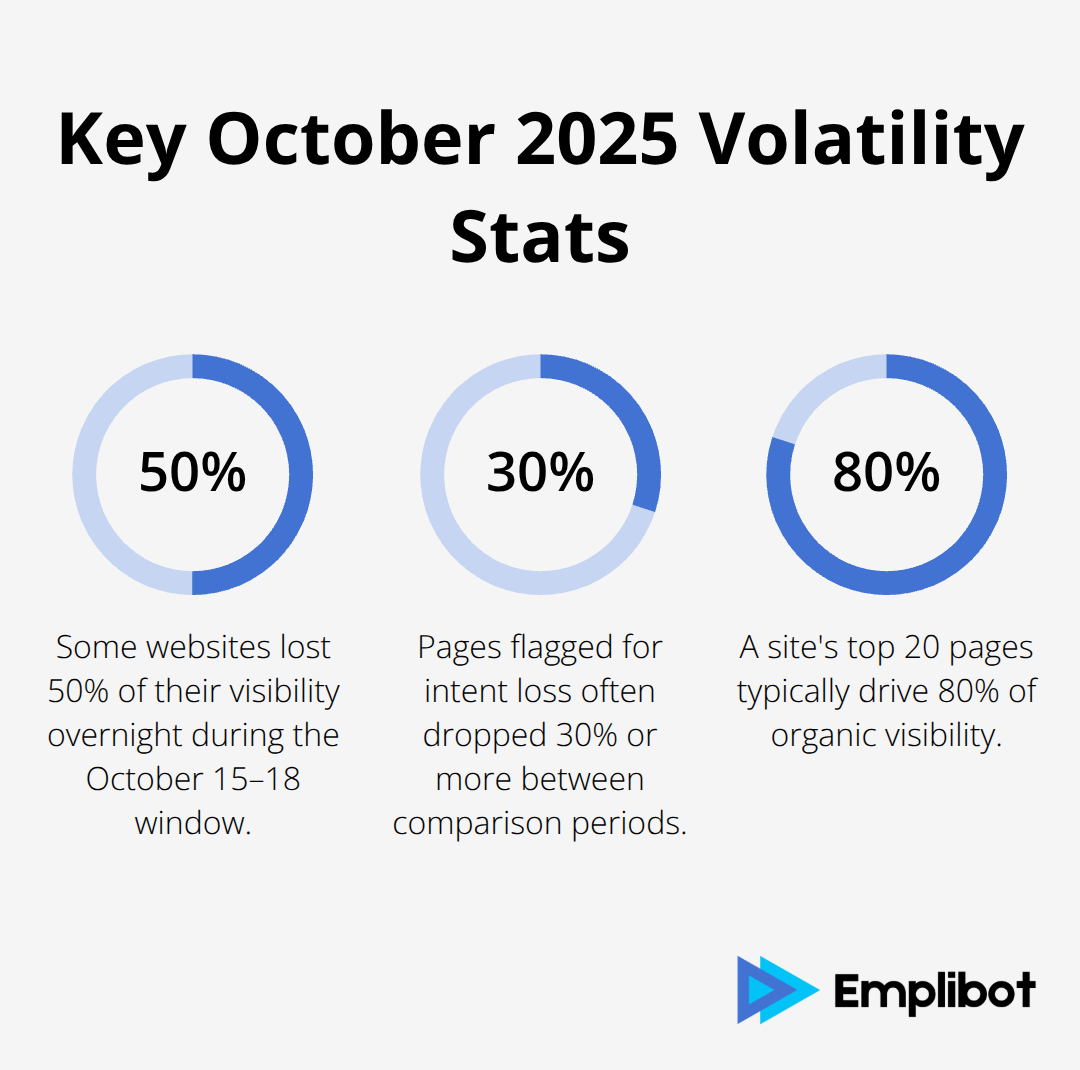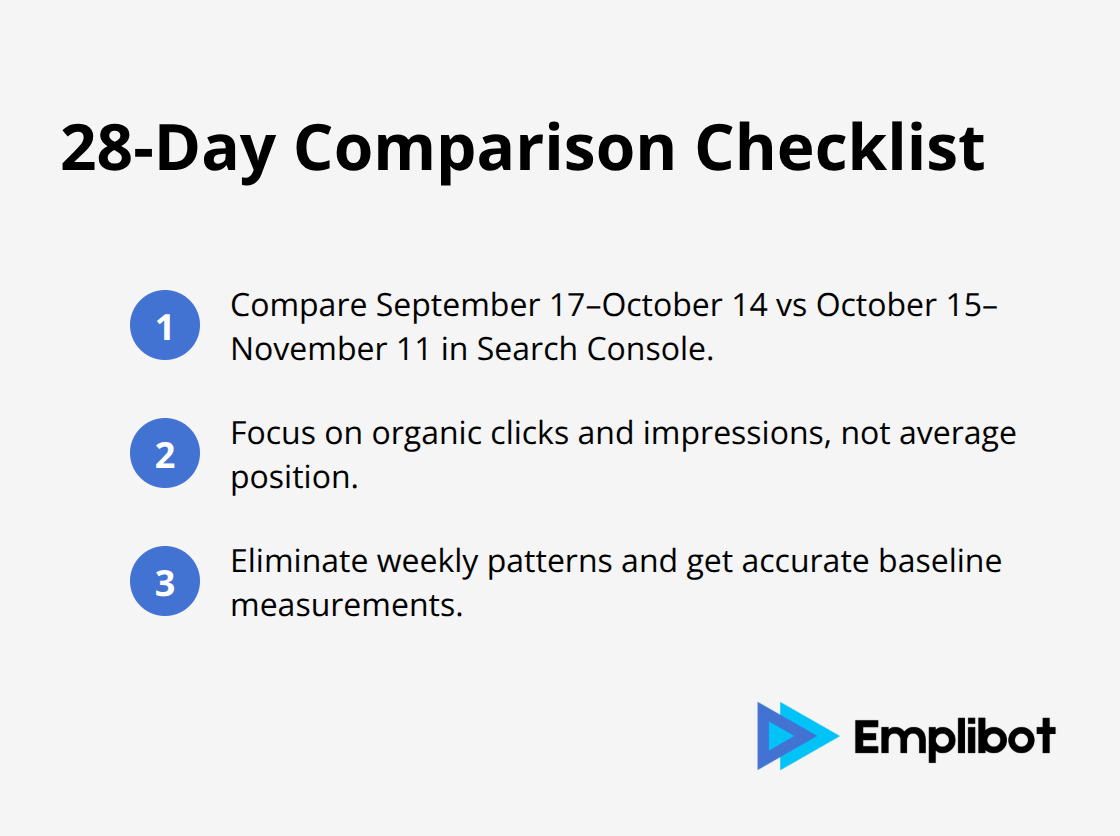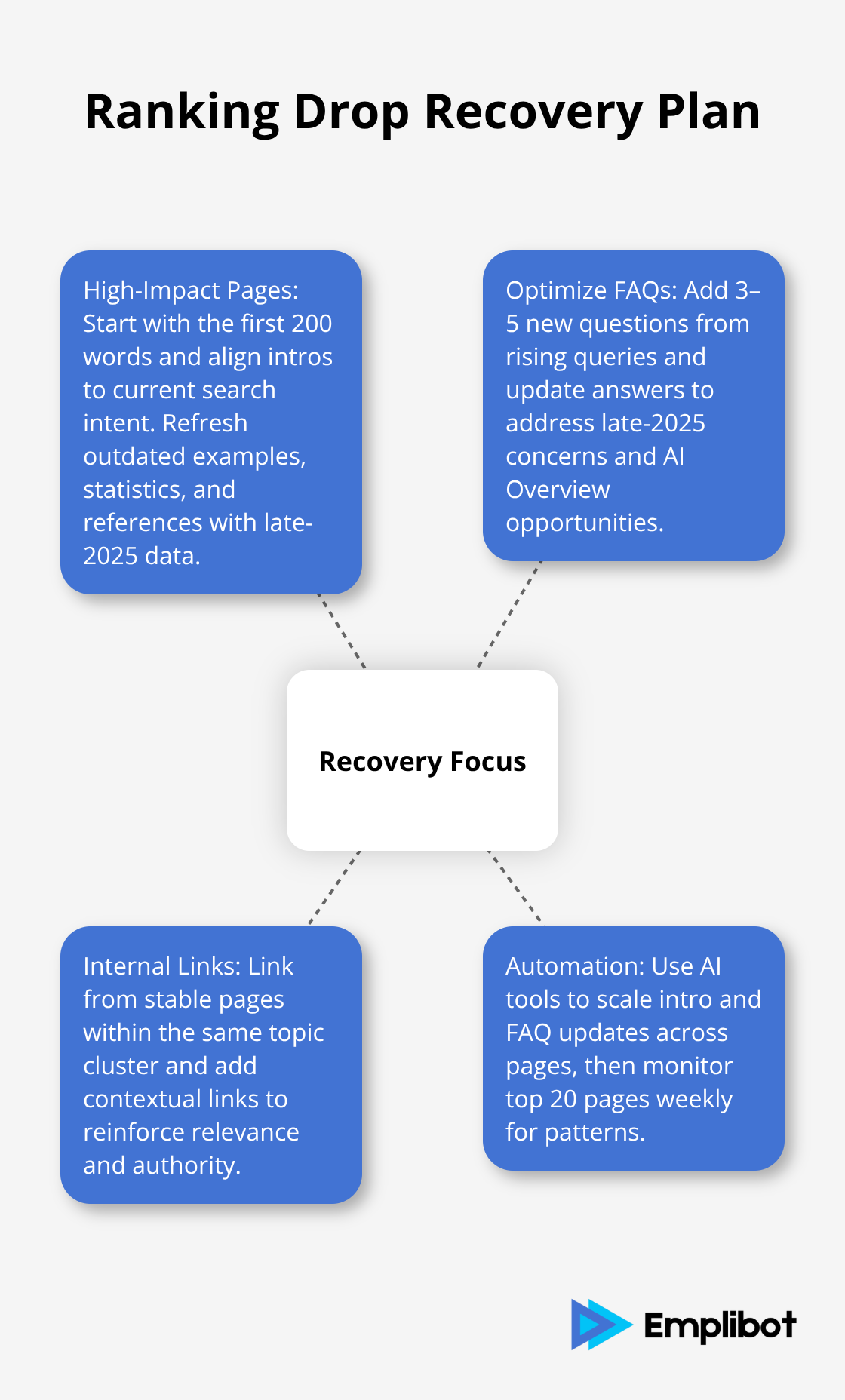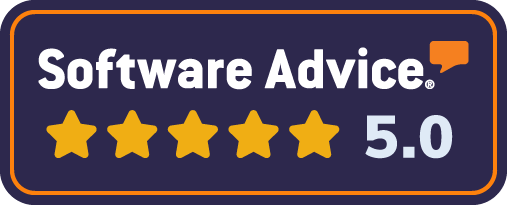Industry monitors reported significant ranking turbulence between October 15-18, 2025, sending many website owners into panic mode.
We at Emplibot see this October 2025 ranking volatility as a normal part of search algorithm adjustments. The key lies in responding with data-driven strategies rather than hasty content changes that often backfire.
Contents
ToggleWhat Caused October 2025 Ranking Chaos
The Scale of Mid-October Disruption
Multiple SEO tracking tools confirmed the severity of October 2025 ranking volatility. Industry monitors reported significant fluctuations during this period, while Mozcast and SERPmetrics showed similar spikes. Some websites lost 50% of their visibility overnight, particularly service and location-based pages.

Google Search Console data revealed traffic drops that reached all-time lows for many sites. The most dramatic changes occurred between October 15-18. These weren’t minor fluctuations but substantial ranking redistributions that affected millions of websites globally.
Search Intent Shifts Drive Rankings Wild
The October volatility highlighted how search intent changes reshape entire result pages. Keywords like “corona” shifted from beer to COVID-19 content, while “X” transformed from music references to Twitter-related searches. When major events occur, Google rapidly adjusts rankings to match new user expectations.
Sites that rank for the old intent get pushed down, while content that matches the new intent rises. This creates massive position swings that look algorithmic but actually reflect user behavior changes. Smart SEO professionals track trending topics and news events that could impact their target keywords (especially during volatile periods).
Panic Reactions Destroy SEO Progress
Website owners who made immediate changes during the October volatility often damaged their rankings further. They rewrote content, changed page structures, or switched keyword targets during active fluctuations. This approach confuses Google’s assessment process.
The algorithm needs stable signals to evaluate content quality and relevance. Sites that waited 72 hours before making changes typically recovered better than those that panicked. Google’s ranking system often rebalances after initial volatility and returns deserving pages to appropriate positions.
Hasty decisions based on temporary drops frequently resulted in permanent traffic losses. The next step involves analyzing your specific traffic data to understand which pages actually need attention (rather than making assumptions based on industry-wide volatility).
How to Read Your Data During Volatility
Google Search Console provides the most reliable foundation for analysis of October 2025 ranking impacts. Compare your traffic data from September 17-October 14 against October 15-November 11 to isolate volatility effects from seasonal trends. This 28-day comparison eliminates weekly patterns and gives you accurate baseline measurements.

Focus on organic clicks and impressions rather than average position, which fluctuates wildly during algorithm updates and provides misleading signals about actual performance changes.
Track Pages That Lost Intent Alignment
Search Console’s Performance report reveals which pages suffered from search intent shifts during the October turbulence. Sort by clicks and identify pages that dropped 30% or more between the comparison periods.
Check if these pages target keywords affected by trending topics or news events that changed user expectations. Pages that rank for outdated search intent need immediate content refreshes to match current user needs, while pages that maintained relevance often recover naturally within two weeks.
Spot Real Problems Versus Temporary Noise
Daily ranking fluctuations during volatile periods create false signals that lead to poor decisions. Weekly traffic patterns show clearer trends than individual day comparisons.
Pages that show sustained decline patterns need attention, while pages with sporadic drops often rebound without intervention. Monitor your top 20 traffic-generating pages specifically, as these represent 80% of most sites’ organic visibility (and provide the strongest recovery signals when algorithm adjustments stabilize).
Identify Recovery Opportunities
Look for pages that maintained or improved their positions during the October volatility. These stable performers often indicate content that aligns well with current search intent and quality standards.
Document which topics, formats, and optimization approaches worked during the turbulence. This data becomes your blueprint for content updates and new page creation moving forward.
Once you understand which pages need attention and which ones performed well, you can develop targeted strategies to strengthen your site’s overall performance.
How Should You Respond to Ranking Drops
Focus Recovery on High-Impact Pages
Target your recovery efforts on pages that lost significant traffic during the October volatility period. Start with the first 200 words of affected pages, as Google places heavy weight on introductory content for relevance signals. Update opening paragraphs to match current search intent patterns, especially if your keywords relate to trending topics or news events that shifted user expectations.
Search Console data reveals which specific queries lost impressions during the ranking volatility. Pages that target these affected queries need immediate content refreshes that align with current search intent. Replace outdated examples, statistics, and references with recent data that matches what users actually search for in late 2025.
Optimize FAQ Sections for Quick Wins
FAQ sections represent immediate optimization opportunities during ranking recovery. Google frequently pulls FAQ content for featured snippets and AI Overviews, which can restore visibility even when main rankings drop. Add 3-5 new questions based on Search Console queries that increased during the volatility period but didn’t convert to clicks.
Update existing FAQ answers with current information that addresses user concerns from late 2025. Focus on questions that directly relate to the search intent shifts you identified in your data analysis.
Strengthen Internal Links from Stable Pages
Pages that maintained rankings during October turbulence should link to pages that dropped, creating authority flow that signals continued relevance to Google. Focus internal linking on pages within the same topic cluster rather than site-wide approaches (which dilute link value and confuse topical authority signals).

Create contextual links within related content rather than navigation-based approaches. This strategy helps Google understand content relationships and can accelerate recovery for affected pages through proper SEO marketing funnel optimization.
Deploy Automation for Content Updates
Modern AI tools for digital marketing can systematically update intro paragraphs and FAQ sections across multiple pages simultaneously. This approach allows you to respond quickly to ranking changes without manual content rewrites that consume weeks of resources. Automation enables rapid content refresh cycles that match the speed of algorithm adjustments.
Monitor your top 20 performing pages weekly and document which content formats, topics, and optimization approaches maintained stability during algorithm adjustments. This data becomes your template for future content updates.
Final Thoughts
The October 2025 ranking volatility tested many website owners, but those who stayed calm and followed data-driven approaches emerged stronger. Panic responses during algorithm updates consistently produce worse outcomes than measured analysis and strategic adjustments. Your Search Console data tells the real story about which pages need attention and which ones performed well during turbulent periods.
Focus recovery efforts on high-impact pages that lost significant traffic, while you strengthen internal links from stable performers to affected content. Sites that maintain consistent optimization practices respond with data rather than emotion when volatility strikes. This systematic approach builds resilience against future algorithm changes that will arrive without warning.
Emplibot automates WordPress blog management and social media distribution across platforms like LinkedIn, Facebook, and Twitter. The platform handles keyword research, content creation, and SEO optimization to maintain consistent performance during algorithm updates. Sites that adopt automated optimization practices continue to thrive in search results regardless of ranking fluctuations (while manual approaches often fall behind during volatile periods).










